The Myth and Reality of ‘The Last Jew of Vinnitsa’ Einsatzgruppen Photograph
Much like the equally famous Ivanhorod Einsatzgruppen Photograph which – as I have explained in detail elsewhere (1) and nor am the only one to have pointed out the obvious issues with this commonly cited ‘Holocaust’ photograph – (2) ‘The Last Jew of Vinnitsa’ Einsatzgruppen Photograph gets routinely trotted out as ‘evidence’ for German atrocities on the eastern front as well as is misrepresented as ‘evidence’ for the ‘Holocaust’ as a whole and yet further it is routinely reproduced in academic and popular books on the subject. (3)
Now given that a significant amount of research work by German historian Jürgen Matthäus working for the ‘United States Holocaust Memorial Museum’ (or USHMM for short) has been done on the photograph in recent years that has cleared up some of the issues around it; it is perhaps time to properly address it and explain what Matthäus doesn’t want to say but is likely aware of.
Now the common reproduction of it is this one:
Another enhanced version of the same photograph – allegedly taken from the diary of a captain in the Heer of the Wehrmacht named Walter Materna – (4) is: (5)
Now what Matthäus has identified is the alleged location that the photo was taken, which is not Vinnitsa at all but rather in the citadel of Berdychiv in the Ukraine. (5) This he argues would place the photo as occurring on 28th July 1941 and shows an operation by Einsatzgruppe C. (6)
This is useful work by Matthäus but he – as already intimated – dodges several significant issues with the photo. The first – as with the Ivanhorod Einsatzgruppen Photograph that alleges comes from the same time period – is providence, which is problematic to say the absolute least.
The problem is that this photograph first appears as far as I can ascertain in 1957 in a German source reader listed as the ‘shooting of Polish jews’ being dated to 1940 (7) and then again circa 1961 in and around the famous Eichmann Trial with the same description (8) and while this doesn’t necessarily mean there should be concerns raised; it does suggest the need for additional scrutiny.
As Matthäus observes but never really explains:
‘The gripping title conveys a degree of certainty that conflicts with the fact that the available archival prints of this photograph lack any descriptors. Rather, archivists created the title based on a description that they believed appeared on the back of one copy of the photograph (now lost) found on the body of a dead German soldier.’ (9)
This should ring all sorts of alarm bells for any historian especially as we are further informed by Matthäus that:
‘Several copies of the photograph survived the war.’ (10)
So how can we have a photograph that ‘was found on the body of a dead German soldier’ that had multiple copies of it apparently in existence, but yet no negatives nor other detail. Matthäus has no answer to this but simply assumes it is genuine, because… well… reasons.
More specific reasons for doubt can be found in the alleged back story of this photo:
‘Photo obtained by Al Moss, of Chicago, a former Nazi concentration camp prisoner, shows the execution of a Polish Jew by a German officer at a mass grave somewhere in Poland. Moss said he obtained the picture in Munich in May, 1945 soon after his liberation by American 3rd Army troops. He said he wanted the people of the world “to know what went on in Eichmann’s time.”’ (11)
So, ‘The Last Jew of Vinnitsa’ Einsatzgruppen Photograph was allegedly first discovered by a jewish ‘former concentration camp prison’ ‘after he was liberated by the American 3rd Army’ – the camp Moss was ‘liberated’ from was the Munich-Allach concentration camp where he was building BMW 801 airplane engines, while the unit which ‘liberated’ Moss was the US 42nd ‘Rainbow’ Infantry Division on 30th April 1945 – some time in Munich in May 1945.
The dating checks out in terms of Moss was in the environs of Munich in May 1945, but the real problem here is that we are supposed to believe that Moss said nothing about this photo of ‘Nazi war crimes’ till either 1957 or 1961 when all of sudden he appears with it and sells it to ‘United Press International’ (UPI) on 5th May 1961 at the latest; (12) several days after the Eichmann trial had begun; UPI then publicize it and it becomes the iconic photo we know today. (13)
The problem here is further increased in so far as we don’t have the original photograph from Moss, and it is interesting to note that Moss originally claimed this showed a German atrocity in Poland in 1940 (14) not in the Ukraine in 1941 as it was subsequently revised to based on ‘based on a description that they believed appeared on the back of one copy of the photograph (now lost) found on the body of a dead German soldier.’ (15)
What I am getting at here is this photograph is unknown before 1957 and to my knowledge never appears anywhere before then, but rather this photograph appears to have appeared for profit nearly two decades after it was allegedly taken.
Further it has been claimed to have all sorts of vague and unevidenced ‘providences’ such as being found ‘the body of a dead German soldier’ or discovered ‘in the personal photo album of a member of the Einsatzgruppen’; (16) showcasing just how little historians actually know about the providence of the photograph.
This should send up all sorts of red flags to any historian and/or researcher, because – much like the Ivanhorod Einsatzgruppen Photograph that appears out of nowhere in a Polish communist propaganda book in 1959 – (17) this suggests that the photograph could very easily be a fake concocted for propaganda, personal gain and/or profit, especially in the context of its ‘discovery’ and publication in the English speaking world just days after the Eichmann Trial had begun in Jerusalem in 1961 after appearing once prior to this in 1957.
It seems all too convenient and suggests that the photograph itself is likely a fake based on the lack of providence, contradictory stories and multiple versions that are stated has having been extant.
But what of the version derived from the copy – not a negative or an original – allegedly found in Walter Materna’s diary and the fact that Materna was in broadly the right place at the right time to have somehow gotten this photograph?
Having read and re-read Matthäus’ work on this it appears that: (18)
A) Materna’s version of ‘The Last Jew of Vinnitsa’ Einsatzgruppen Photograph is not an original but a printed copy.
B) Materna’s version is sharper than the other copies that we have, but the amount of ‘new detail’ is absolutely minimal.
C) Materna’s copy has ‘Late July 1941’ handwritten on the back.
Now the importance of point A is that Materna’s copy is not an original print from a negative let alone a negative (even then this is no guarantee that the photograph has not been faked as such faked negatives were regularly produced during the Victorian era by such methods as double exposure for example), (19) but rather is simply a copy of the photograph that is a bit sharper and with a little bit of ‘new detail’ that could easily – and better - be explained by Materna having an alternative printed copy based on Moss’ original that wasn’t cropped (since what was removed was the sky and surrounding terrain/landmark detail not the detail of the execution and bodies in the photograph) (point B).
The handwritten note may well be Materna’s, but it doesn’t mean that is either his photograph or indicate that he was present at the events that the photograph purports to represent, but rather if it is Materna’s handwriting then it likely represents him dating a photograph based on his own experiences. This would make sense precisely because Materna – if the handwriting is indeed his - inexplicably doesn’t give us the location for the photograph suggesting that he didn’t know it – he doesn’t even say ‘Ukraine’ for example – which then means that the evidentiary value of the handwritten note on the back of the photograph is negligible.
However, the fact that Matthäus has geolocated the background of the photograph to the citadel of Berdychiv in the Ukraine which corresponds well with an Einsatzgruppe C operation there in July 194 is interesting.
There is a problem however because the actual date of the operation being referred to by Matthäus is not 28th July 1941 but rather 30th July with 148 people being executed (20) with reason for the execution performed by the Germans – which we know from the duplicated Einsatzgruppen report regarding the same execution from 8th September 1941 – was because they were jews who had engaged in ‘looting and communist activity’. (21)
So even if the ‘Last Jew of Vinnitsa’ Einsatzgruppen Photograph were genuine and not a fake then it wouldn’t represent what it is claimed to, but rather simply shows a legally valid military execution of looters – remember that for example the British military also mandated execution for looting in the Second World War - (22) and a quasi-legal execution of local political criminals, which both the Western Allies (23) and Soviet Union also engaged in. (24)
The problem with this is that while it is relatively accurate in terms of potential dating; it rules the photograph out of evidence in terms of the ‘Holocaust’ although it makes perfect sense in the context of German anti-partisan doctrine of the time. (25)
But does the concordance between Matthäus’ geolocation of the photo to Berdychiv and the handwritten note on the back of Materna’s copy of the photograph prove anything?
The answer is a flat no and this acts as an easy segway into what we can see on the various copies of the photo itself.
So, let’s remind ourselves of what the various versions look like.
Photo #1 (the most common version):
Photo #2 (the version from Yad Vashem’s photographic archive):
Photo #3 (the enhanced version made from the copy of the photograph from Walter Materna’s diary):
Now we can quickly see that Photos #1 and #2 both severely lack any focus whatsoever in the background, while the enhanced recent version in Photo #3 is much clearer compared to Photos #1 and #2 but it still poor quality with lots of smearing and smudging around the heads of the watching German soldiers, while the prisoner, the executioner and the young soldier in what looks like German panzer corps uniform are in focus. Meanwhile all the other personnel are in varying degrees inexplicably out of focus with the exclusion of the soldiers in the middle who – because he is moving – would naturally be somewhat out of focus.
This suggests that the photograph is in fact a composite one since the background and the foreground simply do mesh at all and where they meet the result is typically blurry, which is a classic sign of the double exposure photographic technique that I have previously mentioned. (26) This can be easily achieved by taking an extant negative or photograph – for example of the inside of the citadel of Berdychiv – then photographing something else on top of that negative or cutting and gluing the cut-out scene you want into place before rephotographing it. (27)
This then gives the effect required while attaining some kind of plausible realism and was a common wartime and post-war tactic used to manufacture such photos; most of which are now completely discarded as ludicrously bad fakes such as this one alleged to be from Buchenwald, but the light and proportions are so… well... off: (28)
The point being that forged German ‘war crime’ photos are not only not unusual but are actually the norm and as such we must be extremely careful around accepting as genuine any such photos especially when we have multiple ‘copies’ that look very different to each other floating around and no original negatives and indeed in this instance not even an original copy to work with.
This is made clearer when we look at the first ever published version of this photograph that I can locate from 1957: (29)
Since aside from the very poor quality of the original copy of the photograph; we can see that once again it is the faces – including this time the young boy in what I presume is the panzer corps uniform who has entirely lost his face – and the executioner seems to have lost his glasses while the German soldier moving on the mound of earth looks like he has acquired chicken legs or has some kind of a large dog at his feet.
No wonder Matthäus is not keen to talk too much about the early versions of this photograph and Knopp wants to breeze past the various different origin stories and versions of the photograph as well, because they display significant differences and oddities to the ‘cleaned up’ modern versions especially the ‘enhanced’ Photo #3 from the copy in Matarna’s diary!
Now another clear problem with this narrative is most easily seen by looking at the ‘enhanced’ modern version of the photograph (Photo #3):
The German soldier here has a very odd uniform on, because while it is a German Wehrmacht uniform: it is band member’s uniform!
You can easily see this in the use of decorative shoulder epaulette wings which signify a bandsman and nothing but a bandsman:
The problem you see is: why is a bandsman wearing his dress uniform epaulette wings to an Einsatzgruppen execution in Berdychiv in July 1941?
We can see how odd this is by looking at this rare photo of a German Wehrmacht band in field uniform during the Second World War where they aren’t wearing their dress uniform epaulette wings:
And in another example this is a photo from a German military band playing in Minsk on the Eastern front during the Second World War:
So why on earth would this German soldier be wearing his dress uniform epaulette wings and why – more importantly – is there are only one band member in this uniform watching the execution when we should reasonably expect there to be multiple?
Indeed this isn’t the only oddity since as we’ve already covered we have a young boy in what looks like a panzer corps uniform – which is strange because the boy looks maybe 16 at best and Germany’s age of conscription was 18 years old till 1944 when it was shifted downward to 16 years old due to the increasingly dire situation on the front lines. (30)
This suggests that this ‘German soldier in a panzer corps uniform’ – as I am sure pro-‘Holocaust’ historians will try to style it – is likely not from 1941 but probably from 1944-1945 with maybe a concession to as early as 1943 but certainly not from the ‘glory days’ of the Wehrmacht in the summer of 1941, which fits with this is being the late or post-war forged photograph that I strongly suspect it is.
In addition to this we have another random inclusion in the form of a single member of the Reichsarbeitsdienst (RAD) in the photograph:
Which is fair enough as the RAD were pretty ubiquitous in the rear areas behind the front lines, but we are forced to ask the same question as we had to in regard to the musicians: why is there only one in the photograph?
It just doesn’t make a whole lot of sense for there to be one musician in dress uniform, one member of the panzer corps (who looks far too young for the time period this photo is claimed to be from) and one member of the RAD in the photograph, because while it is possible it is an odd and very motley group of people which just seems… well… out of place and unusual.
It would however make perfect sense if someone was compiling a fake propaganda photo and thought that a bit of variety would make it look a bit more authentic. This would also explain the fact that we have no original negative of this photo nor even an original copy, but rather over time the photo seems to get more and more ‘enhanced’ to make it seem less obviously a fake.
Where did the photo come from?
In truth we don’t know for certain because the origins of it are unknown other than Moss’ unverified later story that he acquired it in May 1945 in Munich, which is in itself off because one wonders who he acquired it from, in what context (did he pay for it?) and so on.
None of these questions have been answered by Matthäus and others, but instead we are left with an alleged photo – which was of horrible quality – that appears out of nowhere in 1957 in a German book; then the photo is revealed again by Al Moss on 5th May 1961 when he sells it to ‘United Press International’ whereupon it is then heavily syndicated and begins to appear in books on the ‘Holocaust’ but yet we don’t have the original print this photo is based off of let alone the negative.
It all sounds rather like ‘The Last Jew of Vinnitsa’ Einsatzgruppen Photograph was created between May 1945 and 1957 – we may reasonably assume for profit and/or propaganda - and is not a genuine photograph: doesn’t it?
I’d say so.
References
(1) See my article: https://karlradl14.substack.com/p/the-myth-and-reality-of-the-ivanhorod and my response to the only attempt to try and rehabilitate the photograph against my criticism: https://karlradl14.substack.com/p/does-the-ivanhorod-einsatzgruppen
(2) See my article: https://karlradl14.substack.com/p/an-english-translation-of-professor
(3) Jürgen Matthäus, 2023, ‘”The last Jew in Vinnitsa”: Reframing an Iconic Holocaust Photograph’, Holocaust and Genocide Studies. Vol. 37, No. 3, p. 349
(4) Ibid., pp. 349-359
(5) https://www.theguardian.com/world/2025/oct/02/historian-uses-ai-to-help-identify-nazi-in-notorious-holocaust-image
(6) Idem.; Matthäus, Op. Cit., pp. 349-359
(7) R. Schnabel, 1957, ‘Macht ohne Moral’, 1st Edition, Roederberg Verlag: Frankfurt-am-Main, p. 307 quoted in Udo Walendy, 1989, ‘Forged “War Crime” Photos Malign the German Nation’, 2nd Edition, Verlag fur Volkstum und Zeitgeschichtsforschung: Vlotho, p. 42
(8) Matthäus, Op. Cit., p. 349
(9) Idem.
(10) Idem.
(11) https://digital.kenyon.edu/bulmash/1085/
(12) Idem.
(13) Matthäus, Op. Cit., p. 349
(14) https://digital.kenyon.edu/bulmash/1085/; Walendy also quotes two examples from 1962 and 1966 where this photograph was so described as being the execution of ‘Polish jews’ in Hans-Adolf Jacobsen and Hans Dollinger, 1962, ‘Der Zweite Weltkrieg in Bildern und Dokumente’, Vol. I, 1st Edition, Verlag Kurt Desch: Munich, p. 100 and in ‘Der Spiegel’, 1966, No. 51, p. 86 (Udo Walendy, ‘Forged’, Op. Cit., p. 42)
(15) Matthäus, Op. Cit., p. 349
(16) Guido Knopp, 2014, ‘Der zweite Weltkrieg: Bilder, die wir nie vergessen’, 1st Edition, Edel: Hamburg, pp. 146–151
(17) See my article: https://karlradl14.substack.com/p/the-myth-and-reality-of-the-ivanhorod
(18) Matthäus, Op. Cit., pp. 349-359
(19) See for example: Blake Smith, 2010, ‘From the Edge of Postcards: The Wem Ghost Photo’, Skeptical Inquirer, Vol. 34, No. 5, pp. 48-50
(20) Carlo Mattogno, 2018, ‘The Einsatzgruppen in the Eastern Territories: Genesis, Missions and Actions’, 1st Edition, Castle Hill: Uckfield, p. 259
(21) Ibid., p. 178
(22) https://www.bbc.com/news/uk-england-33566789
(23) Cf. James Bacque, 1997, ‘Crimes & Mercies: The Fate of German Civilians under Allied Occupation, 1944-1950’, 1st Edition, Little, Brown and Company: Boston; James Bacque, 2004, ‘Other Losses: An Investigation into the Mass Deaths of German Prisoners at the Hands of the French and Americans After World War II’, 2nd Edition, Little, Brown and Company: Boston
(24) Cf. Vadim Birstein, 2013, ‘SMERSH: Stalin’s Secret Weapon’, 1st Edition, Biteback: London
(25) Cf. Philip Blood, 2006, ‘Hitler’s Bandit Hunters: The SS and the Nazi Occupation of Europe’, 1st Edition, Potomac: Sterling
(26) Smith, Op. Cit., pp. 48-50
(27) On this see: Sir Campbell Stuart, 1921, ‘Secrets of Crewe House: The Story of a Famous Campaign’, 1st Edition, Hodder & Stoughton: London, pp. 50-104; Sir Arthur Ponsonby, 1928, ‘Falsehood in War-time: Containing an Assortment of Lies Circulated Throughout the Nations During the Great War’, 2nd Edition, George Allen & Unwin: London, pp. 135-139; Udo Walendy, 1979, ‘The Methods of Re-Education’, 1st Edition, Verlag fur Volkstum und Zeitgeschichtsforschung: Vlotho, pp. 18-19
(28) Udo Walendy, ‘Forged’, Op. Cit., p. 24
(29) Ibid., p. 40
(30) https://warfarehistorynetwork.com/article/nazi-war-machine-why-wwii-german-army-was-so-strong


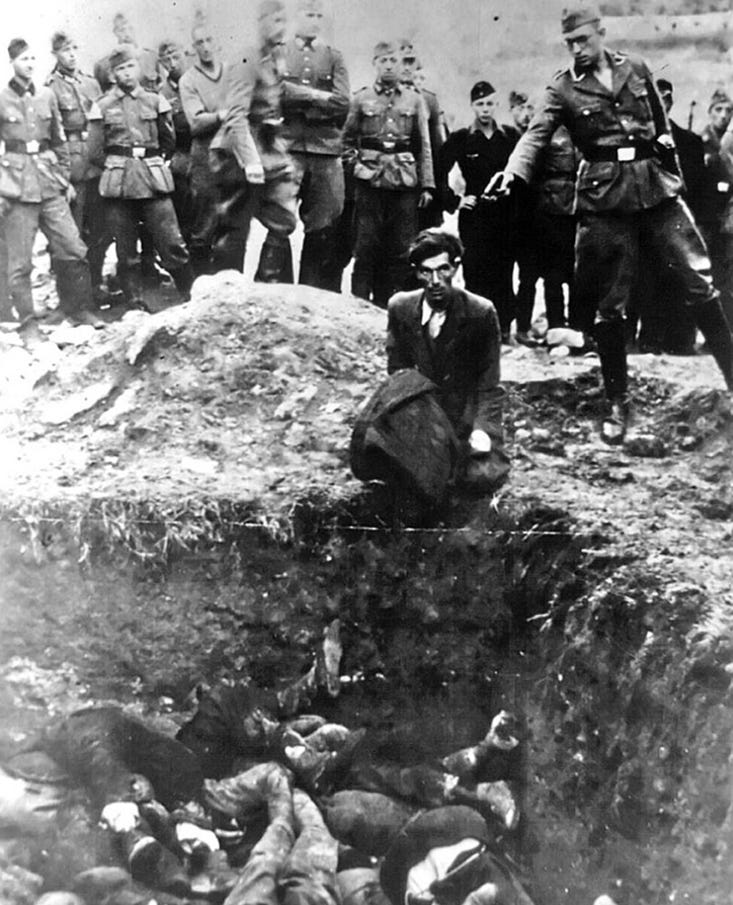
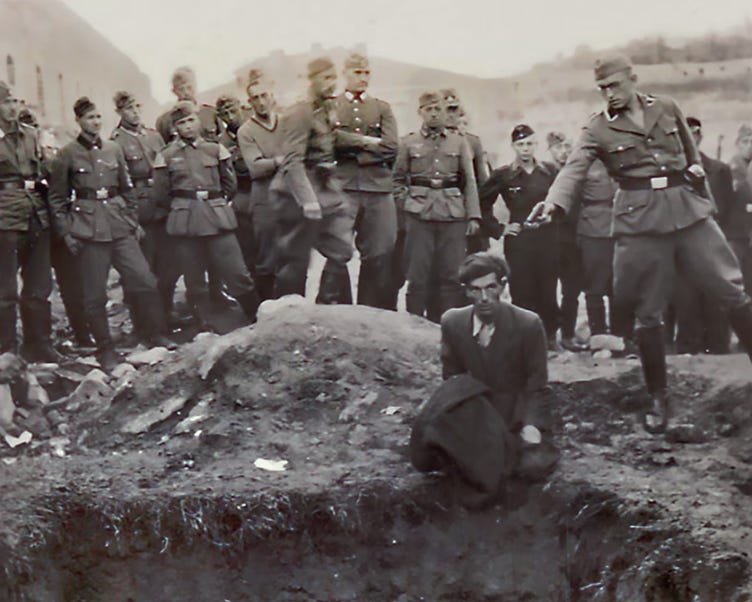
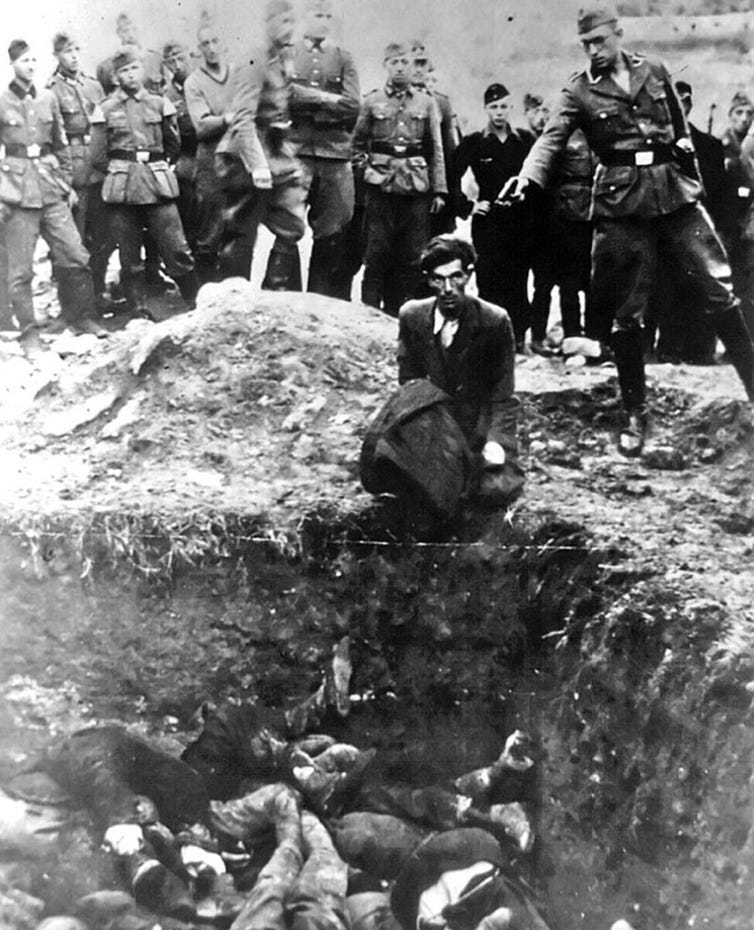
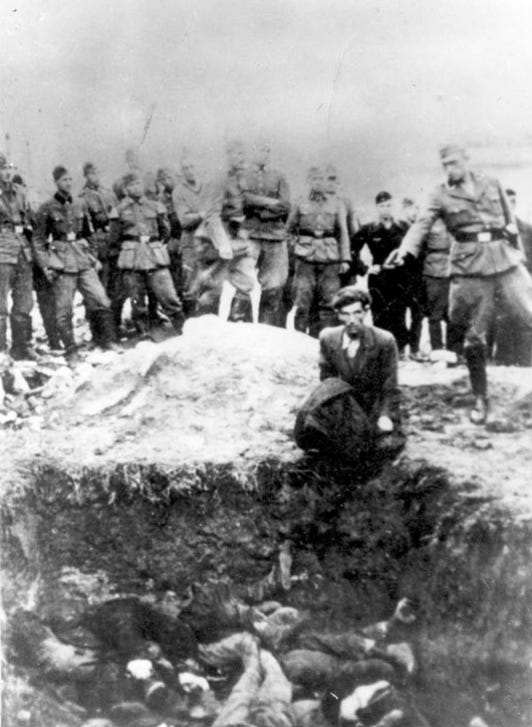
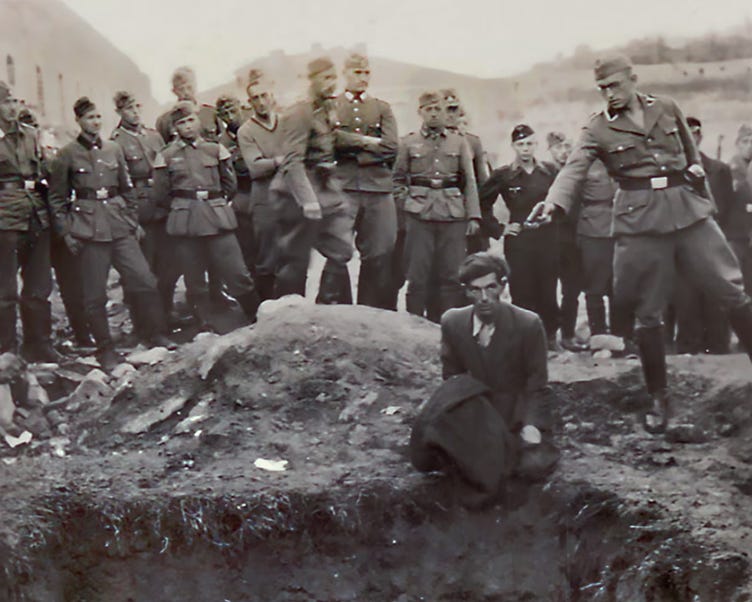
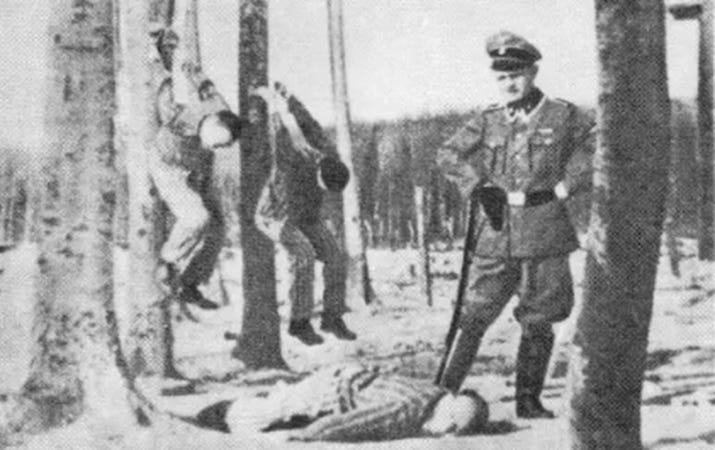
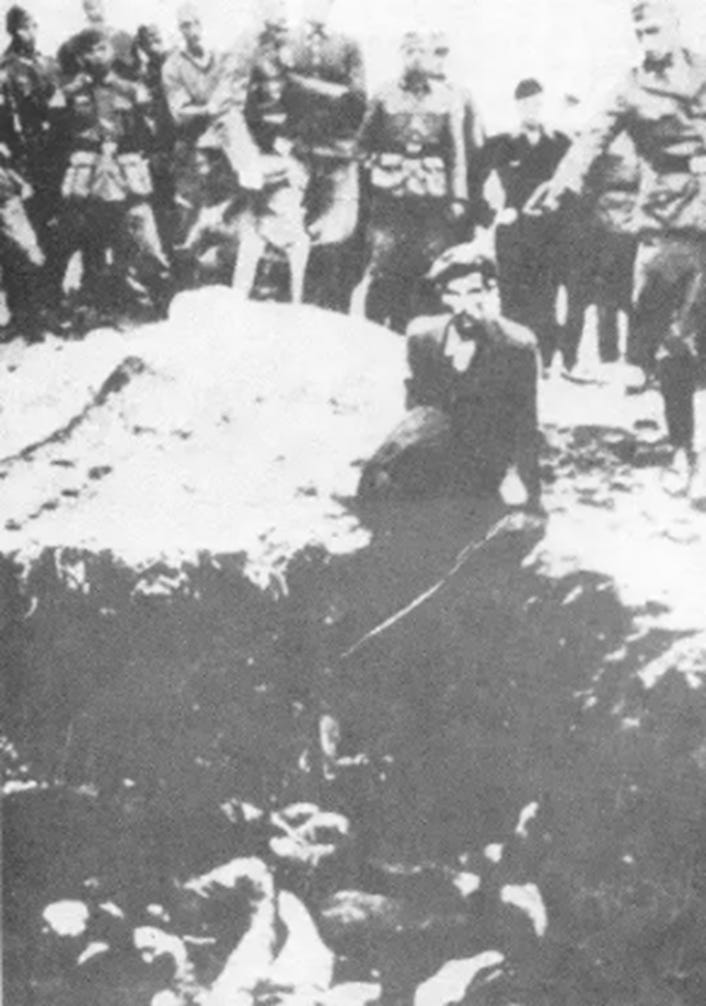
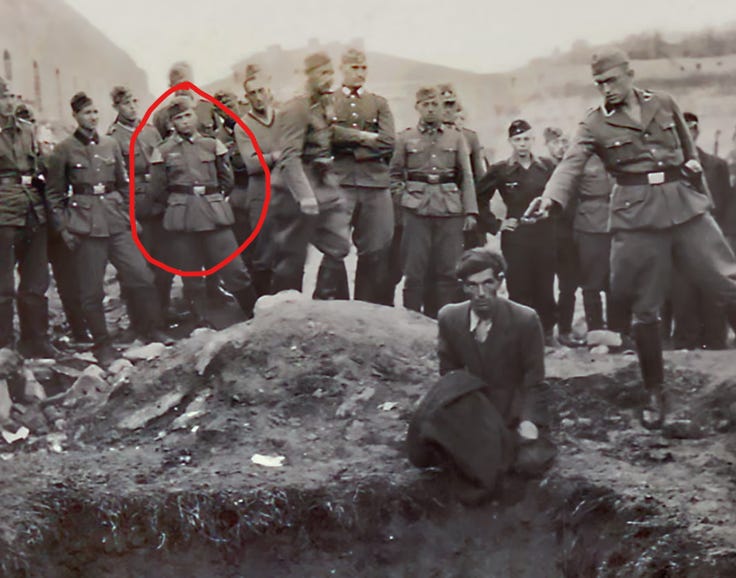
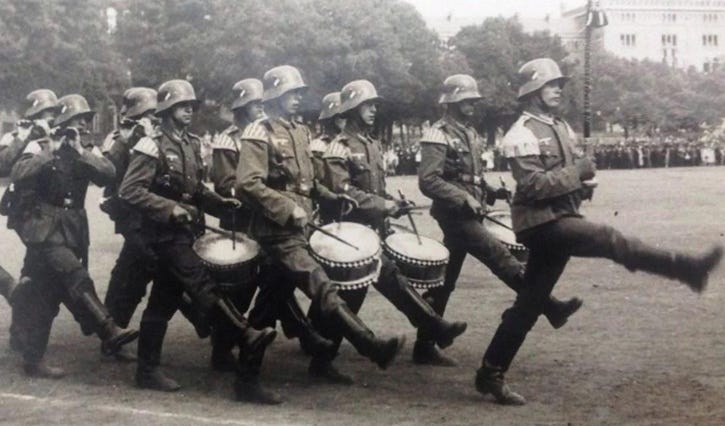

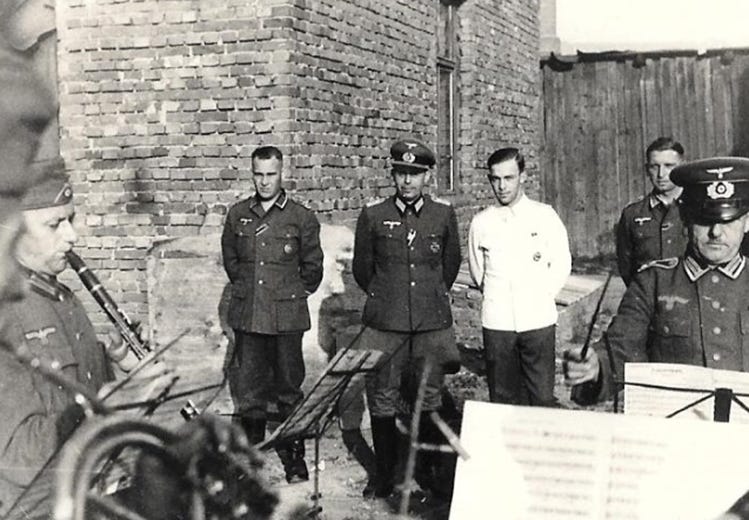
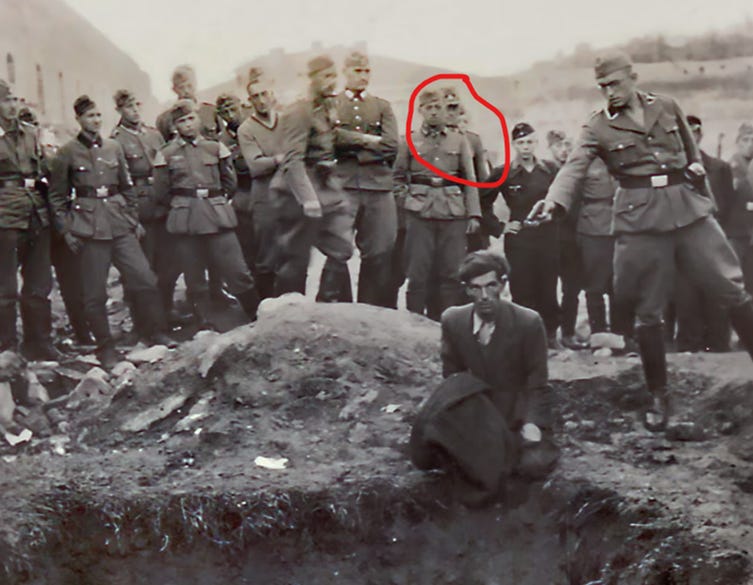
It’s worth emphasizing the quantity and quality of photo editing all the way back to the 1800’s. I watched a documentary about the compilation of the books they sold of the 1893 Chicago World’s Fair. They edited an insane number of photos for that book. By the 1940’s that skill was at an elite level. Great article Karl. I’ll never look at that photo the same way again!
Thankyou for researching this so deeply, this photograph is thoroughly revealed by you here as a very clear example of an obviously faked Russian (Jewish)-made photo, with some of the soldiers originally having no faces on, which shows that the fakers simply could not be bothered to add further detail, or that they were crudely intending in their naivety to lend the forged photo some atmosphere of antiquatedness, yet the German photographic lenses made by Zeiss that the German armed forces themselves actually used produced extremely clear photographic images, and why would any German soldier ridiculously carry such an extremely poor quality and obviously faked image around with him waiting to be 'discovered' later on their dead body?